Best coral-friendly and easy-to-care fish for beginners’ reef tanks
When you decided to start up a saltwater tank hopefully you did some basic thinking as to what type of tank you want – just corals? just fish? live rock with fish? or a true to life reef with corals and fish? If you are looking to have fish, how do you pick the best ones to start out with?
- How to choose saltwater fish for a beginner?
- Basslets
- Blennies
- Cardinal fish
- Clownfish
- Dartfish
- Dottybacks
- Firefish
- Rabbitfish
- Wrasses - Fairy
- Wrasses - Flasher
- References, resources, and more readings
How to choose saltwater fish for a beginner?
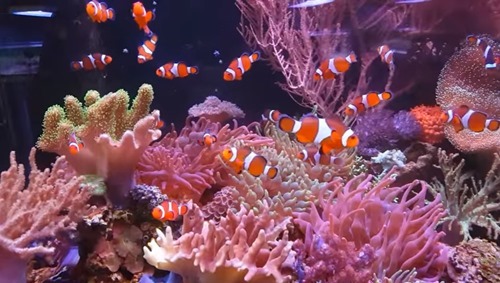
There are many things to consider before purchasing your first fish:
- Tank Type: Fish only tank, fish only with rock, or fish with coral? This is the first question you need to answer.
- Tank Conditions: What their needs for water temperature, alkalinity dKH, pH, and salinity; not all fish thrive under the same parameters.
- Tank Size: Is the size (gallons) and shape (cube, tall, long) of your tank a good fit to the habits of your fish.
- Fish Size: How big will they grow and is that compatible with your tank size. Are they compatible with the aquascape you have in your tank?
- Temperament/Compatibility: How will they get along with other fish and/or corals you have or intend to have in the tank. Are they peaceful or aggressive?
- Diet: Are they herbivores, carnivores, scavengers, or some combination. How do you need to feed them to meet their needs?
- Feeding Requirements: What is the natural diet and how narrow is it? Do they need live food? How are they fed?
- Handling: Are they venomous or have other special attributes that can affect how you handle them.
- Source: Were they tank raised (captive bred) or wild-caught? Tank raised fish are more acclimated to the tank environment and don’t deplete wild populations. Wild-caught species can be more difficult to acclimate and may be harvested in an unsustainable manner. Looking for Marine Aquarium Council (MAC) or knowing the harvesting practices of the source is the best practice for all in the hobby.
- Price: While you strive for the best outcome for all your tank inhabitants, there is a cost reality for most of us.
- Health: You will want to be able to assess the overall health of a specimen before purchase. This entails looking for physical and behavioral indicators of illness or stress. When possible visit the supplier to observe their practices.
- Quarantine: Do you have a quarantine area and procedure set up for your new purchase? Quarantine is your best defense against bringing in an unwanted disease that could wreak havoc on your tank.
Doing your homework before you go out to buy will help you to make good choices for your tank, the other inhabitants you have or intend to have, and your wallet!
Here are some of the choices (listed alphabetically) considered to be best for new tanks and new hobbyists.
Basslets
A great choice for beginners due to their resistance to protozoan disease, bacterial infections, and short term declines in water quality. They will need an aquarium with plenty of rockwork with some calm areas for resting and darker areas and/or subdued lighting. They need a diet containing a variety of chopped meaty items, including marine fish, vitamin-enriched brine and mysis shrimp, crustacean flesh, meaty frozen and flake preparations.
Chalk bass (Serranus tortugarum)
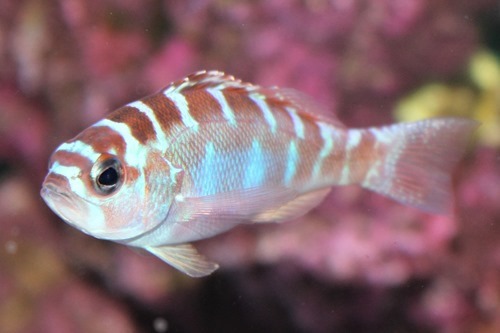
Serranus tortugarum, source
- Min tank size: 30 gallons
- Temperament: Semi-aggressive
- Reef safe: yes
- Temperature: 72-78 °F
- Water: pH 8-12, dKH 8.1-8.4, sg. 1.020-1.025
- Max size: 3 inches
- Diet: carnivore
- Care level: Easy
From the Atlantic, usually found within the benthic regions of intertidal reef zones, making it ideal for the reef aquarium. They may be reclusive initially. They generally not aggressive towards other fish and if introduced at the same time, multiple specimens can be added. Larger specimens may attack small shrimps, especially the Periclimenes genus. They are slow to mature, rarely growing more than 3 inches.
Royal gramma (Gramma loreto)
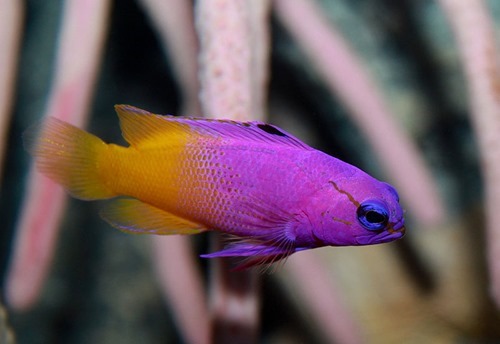
Gramma Loreto, Brian Gratwicke
- Min tank size: 30 gallons
- Temperament: Peaceful
- Reef safe: yes
- Temperature: 72-78 °F
- Water: pH 8-12, dKH 8.1-8.4, sg. 1.020-1.025
- Max size: inches
- Diet: carnivore
- Care level: Easy
May also be called Fairy Basslet. Native to deepwater reefs of the Caribbean. Peaceful toward tank mates of similar size and temperament but can be aggressive towards its own kind and is best kept as a single specimen.
Avoid confusing with similar looking and more aggressive Pseudochromis paccagnella and Gramma brasiliensis. Royal Gramas have a spotted gradual color change from purple to yellow and two reddish lines that run through the eye and head.
Blennies
Blennies usually spend a lot of time on or near the tank bottom while some will burrow into the substrate or hide in reef crevices or empty shells. Overall, most like to perch on a rock or squeeze into tight spaces and watch. In aquariums, you need to provide these suitable hiding and perching places.
These fish are normally peaceful tank members but have been known to pick at other blennies, smaller gobies, and dartfish.
Suitable for reef aquariums but in a smaller setup or one with smaller fleshy corals they may pick at fleshy large polyp stony corals, clam mantles, and may attach invertebrates – especially when underfed. Blennies are good jumpers so a secure lid or high guard is necessary.
Bicolor blenny (Ecsenius bicolor)
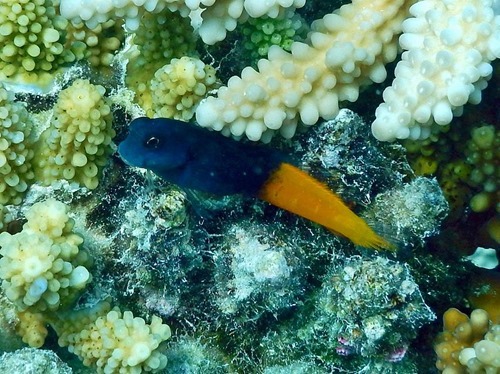
Ecsenius bicolor, source
- Min tank size: 30 gallons
- Temperament: Peaceful
- Reef safe: yes
- Temperature: 72-78 °F
- Water: pH 8-12, dKH 8.1-8.4, sg. 1.020-1.025
- Max size: 4 inches
- Diet: Herbivore
- Care level: Easy
Midas Blenny (Ecsenius midas)
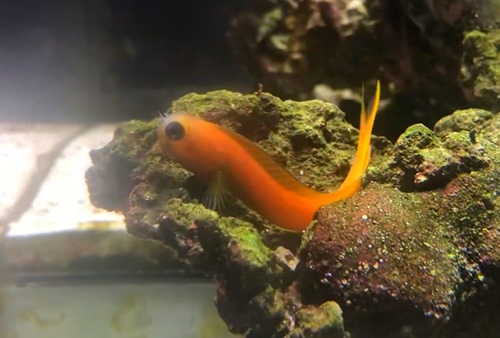
- Min tank size: 30 gallons
- Temperament: Peaceful
- Reef safe: yes
- Temperature: 72-78 °F
- Water: pH 8-12, dKH 8.1-8.4, sg. 1.020-1.025
- Max size: 6 inches
- Diet: Omnivore
- Care level: Easy
Midas Blennies are omnivores and require a meaty diet that includes Mysis, finely chopped crustacean flesh, and vitamin-enriched brine shrimp in addition to the herbivorous requirements listed above for the bicolor blenny.
Cardinal fish
Banggai cardinal (Pterapogon kauderni)
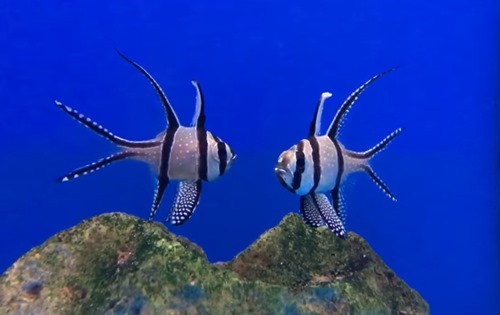
- Min tank size: 30 gallons
- Temperament: Semi-aggressive
- Reef safe: yes
- Temperature: 72-78 °F
- Water: pH 8-12, dKH 8.1-8.4, sg. 1.020-1.025
- Max size: 3 inches
- Diet: carnivore
- Care level: Easy
Other names: Highfin Cardinal, Kaudern’s Cardinalfish. Look for tank bred specimens (easily found) for purchase and recommended as wild-caught specimens from their native Banggai Islands in Indonesia are being pressured.
As slow, mid-level methodical swimmers, they need at minimum a 30-gallon tank with a cave. Better when kept as a single fish or mated pair in smaller tanks; aggressive behavior can occur when they are kept in larger groups.
Cardinal fish are mouthbrooders with the male (discerned by a more rounded jaw than the female) carrying the eggs in his mouth to protect them after spawning. Mated pairs are relatively easy to breed and raise the fry.
They are carnivores and need a well-balanced meaty food diet such as adult brine shrimp, feeder shrimp, chopped seafood, Mysis shrimp, bloodworms, live feeder fish as well as frozen preparations for carnivore fish.
Clownfish
Suitable starter species include the Black Oscellaris Clownfish (Amphiprion ocellaris var) and the Orange Ocellaris Clownfish (Amphiprion ocellaris). There are many species of clownfish but they are not all suitable starter fish.
As a general rule, they will do well singly or as a pair. Pairs are best added together at a young age, as a pair with a noticeable size difference, or as a mated pair. More than one pair in a tank is not recommended as they can be very territorial.
In the wild, they often host an anemone for protection. In a home aquarium, the protection need isn’t there (and that anemones are not a beginner species) they will find a coral, powerhead, or another item in the tank to host in.
Clownfish are one of the most successfully captive-bred species and finding tank-raised specimens should be easy plus they will quickly acclimate to the tank environment and are less apt to carry or contract illness.
Ocellaris clownfish (Amphiprion ocellaris)

- Min tank size: 20 gallons
- Temperament: Peaceful
- Reef safe: yes
- Temperature: 72-78 °F
- Water: pH 8-12, dKH 8.1-8.4, sg. 1.020-1.025
- Max size: 3 1/2″ inches
- Diet: Omnivore
- Care level: Easy
Also known as False Percula Clownfish, Anemone Fish, and Anemone Demoiselle. Ocellaris clowns have an orange background and 3 white bars that circle the fish.
They are considered peaceful and reef tank safe. Their smaller size and territorial conduct make them a choice for smaller tanks; they don’t normally chase other fish very far from their home territory and other tank mates learn to avoid the area.
They eat any meaty food offerings such as mysid shrimp, bloodworms, brine shrimp, and frozen meaty and herbivore preparations. Be an informed buyer as this species is sometimes sold as the Percula Clown (Amphiprion percula); the color pattern is very similar but not as bright orange.
Black Ocellaris clownfish (Amphiprion ocellaris var.)
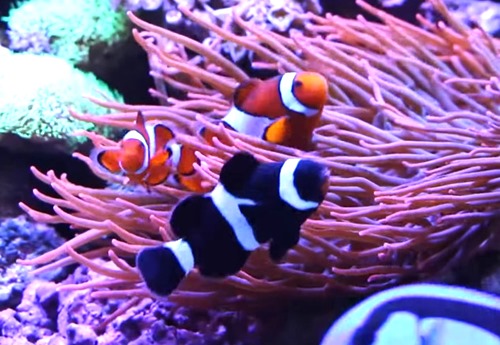
- Min tank size: 20 gallons
- Temperament: Semi-aggressive
- Reef safe: yes
- Temperature: 72-78 °F
- Water: pH 8-12, dKH 8.1-8.4, sg. 1.020-1.025
- Max size: 3 inches
- Diet: Omnivore
- Care level: Easy
They are also known as the Black Perc, Black Percula Clown Anemonefish, Black and White False Percula Clown. They are the same species as the orange ocellaris clownfish above, just a color variant originally native to the Coral Sea reefs.
The juvenile stage will look like an orange clownfish but as they mature the skin becomes increasingly darker until it is jet black with three vertical white stripes outlined with a fine black line and they may retain a bit of their orange color on the face.
They are very hardy and a good option for novice or seasoned reef tank aquarists. As omnivores, they need both meaty foods as well as herbivore preparations in their diet. They are sometimes incorrectly sold as Black Percula Clown.
Dartfish
These are a very close cousin to the firefish but schooling in nature. They are characterized by bright colors and elongated bodies. They need an aquarium with plenty of swimming rooms, some hiding spots, and at least 2 inches of a sandy substrate for burrowing. They are jumpers so a tight-fitting canopy is required and they are not recommended for open-top tanks.
Zebra barred dartfish (Ptereleotris zebra)
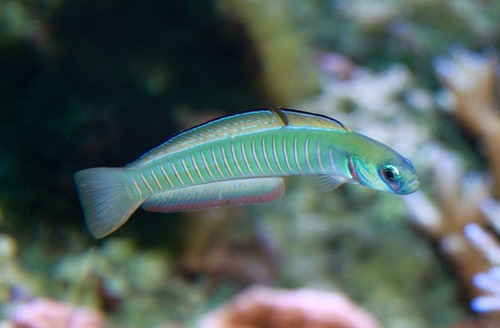
Ptereleotris zebra, source
- Min tank size: 30 gallons
- Temperament: Peaceful
- Reef safe: yes
- Temperature: 72-78 °F
- Water: pH 8-12, dKH 8.1-8.4, sg. 1.020-1.025
- Max size: 4 inches
- Diet: Carnivore
- Care level: Easy
Also known as Zebra Dart Goby, Bar Goby, Barred Dartfish, Zebra Goby, Chinese Zebra Goby. It has a light green head and body with numerous vertical, evenly-spaced thin orange stripes.
They are a very close cousin to the firefish but are schooling by nature and do better when kept as a school of 6 or more. If you choose to have more than one, they need to be introduced all at the same time to the tank. They need a meaty diet that includes fresh or frozen seafood and brine and Mysis shrimp.
Dottybacks
Sometimes called by their genus name, dottybacks are brightly colored and very hardy. They feed on plankton, small crustaceans, worms, and accepting of most prepared foods.
Your aquarium will need a well-sealed lid. They prefer vertical rock faces or overhangs so your tank will need plenty of rockwork and hiding places.
If you want more than one, introduce them all at once or look for a mated pair and keep only one species in a tank. Also, avoid keeping other fish of similar look/coloring (such as a Royal Gramma) and wrasses. Shy at first, it will venture out of its hiding places as it acclimates.
Orchid Dottyback (Pseudochromis fridimani)
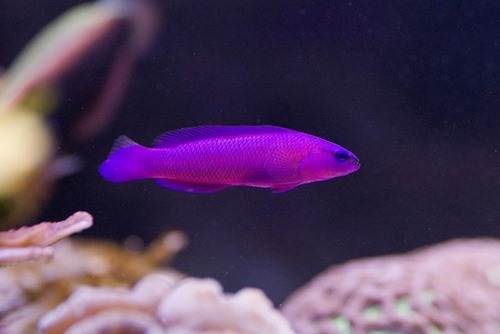
Pseudochromis fridimani, source
- Min tank size: 30 gallons
- Temperament: Semi-aggressive
- Reef safe: yes
- Temperature: 72-78 °F
- Water: pH 8-12, dKH 8.1-8.4, sg. 1.020-1.025
- Max size: 3 inches
- Diet: Carnivore
- Care level: Easy
They naturally occur in the Red Sea but increasingly are available as tank bred (and much less expensive). Don’t mix with other dottyback species. May chase smaller fish and will defend its hiding places.
Feed meaty foods including brine shrimp and prepared frozen. They don’t bother corals, will also prey on small mantis shrimp and bristle worms making them a good addition for reef tanks.
Firefish
Suitable starters are the Red Firefish (Nemateleotris magnifica) and the Purple Firefish (Nemateleotris decora). They stay fairly small making them suitable for a range of tank sizes.
Firefish are best kept as a single fish or mated pair. They will need multiple rocky outcroppings, craigs, or loose rock rubble areas they can duck into if feeling threatened. In the wild they inhabit burrows on the upper portion of outer reef slopes and hover above the bottom, facing the current to feed on zooplankton.
In the aquarium, provide moderate lighting conditions and a moderate current passing over their reef. They will feed on suspended water column prey as well as picking algae off the substrate. Firefish are known to be jumpers when spooked and not recommended for open-top tanks.
Feed a varied diet of finely chopped or shaved seafood, vitamin-enriched brine fish (live or frozen), Mysis shrimp, and prepared foods; their vibrant coloring will fade if not fed a vitamin-enriched diet.
Red Firefish (Nemateleotris magnifica.)
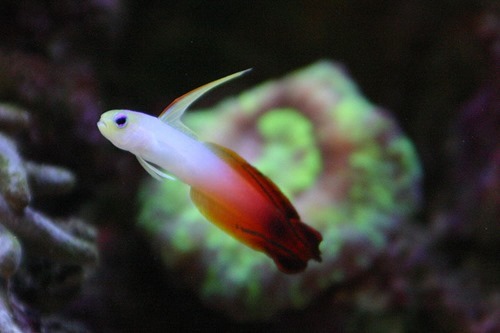
Nemateleotris magnifica, source
- Min tank size: 10 gallons
- Temperament: Peaceful
- Reef safe: yes
- Temperature: 72-78 °F
- Water: pH 8-12, dKH 8.1-8.4, sg. 1.020-1.025
- Max size: 3 inches
- Diet: Carnivore
- Care level: Easy
Also called the Fire Dartfish, Fire Goby, Red Fire Goby.
Purple firefish (Nemateleotris decora)
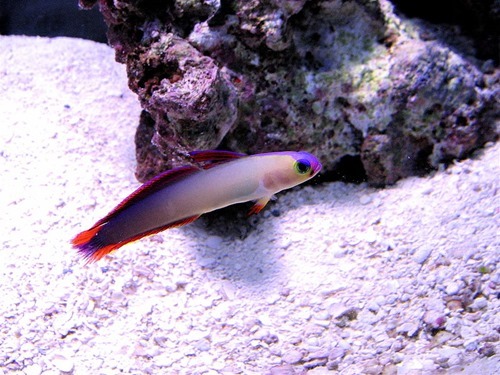
Nemateleotris decora, source
- Min tank size: 10 gallons
- Temperament: Peaceful
- Reef safe: yes
- Temperature: 72-78 °F
- Water: pH 8-12, dKH 8.1-8.4, sg. 1.020-1.025
- Max size: 3 inches
- Diet: carnivore
- Care level: Easy
Also called the Decorated Dartfish, Decorated Firefish, Elegant Firefish, Elegant Firegoby, Purple Firegoby, or Flame Firefish. Rarely aggressive towards other fish, it is territorial and will fight with its own kind unless a mated pair.
Rabbitfish
Rabbitfish are reef fish inhabiting lagoons and seaward reefs. They occur singly or in pairs, sub-adults can form large schools. In the wild, older adults form pairs and should be given the same opportunity in the aquarium. They grow to 7 -9 inches and will need a large tank that provides ample swimming space.
They will get along with others of the same species but should not be combined with other Rabbitfish. Overall a good community fish, they combine with other peaceful, or slightly more aggressive species; predatory fish normally leave Rabbitfish species alone due to their venomous spines. Because of this, Rabbitfish require caution during handling to avoid being stung.
All rabbitfish have the ability to camouflage themselves when feeling threatened, sleeping, or anytime they want to just blend into the surroundings.
They are primarily an algae-eating herbivore and will leave smaller fish and invertebrates alone. It is reef compatible with caution; they can nip and eat some soft and LPS corals, especially when not adequately fed. Feeding them well a varied diet and having naturally available algae for grazing will help alleviate this.
Foxface Rabbitfish are considered very hardy. Suitable starter species are the Magnificent Foxface (Siqanus magnificus), Foxface Lo (Siganus vulpinus), and One Spot Foxface (Siganus Unimaculatus).
Magnificent Foxface (Siganus magnificus)
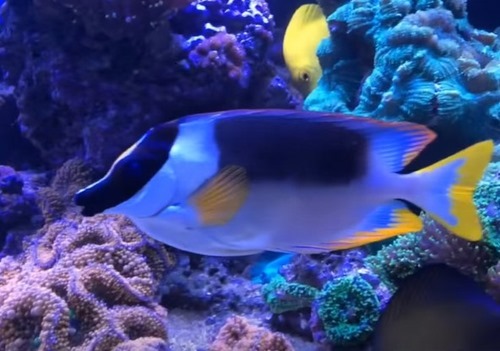
- Min tank size: 125 gallons
- Temperament: peaceful
- Reef safe: yes
- Temperature: 72-78 °F
- Water: pH 8-12, dKH 8.1-8.4, sg. 1.020-1.025
- Max size: 9 inches
- Diet: herbivore
- Care level: Moderate
Also called Magnificent Rabbitfish, Andaman Foxface, or Red Fin Foxface. It can look discolored, even developing spots, when it is acclimatizing to a new home but this goes away when the fish has become used to your aquarium. Fairly rare and more expensive than its more common cousins below. Feed a variety of fresh vegetables and will eat undesirable species of algae in the tank.
Foxface Lo (Siganus vulpinus)
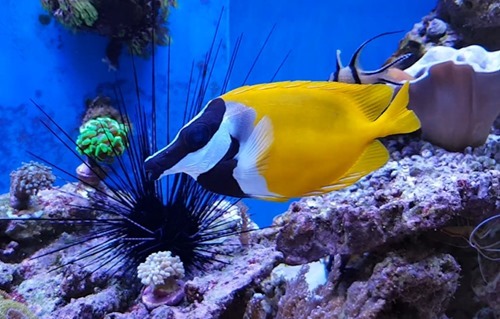
- Min tank size: 125 gallons
- Temperament: peaceful
- Reef safe: yes
- Temperature: 72-78 °F
- Water: pH 8-12, dKH 8.1-8.4, sg. 1.020-1.025
- Max size: 9 inches
- Diet: herbivore
- Care level: Easy
Also called Foxface Rabbitfish. They have a mottled yellow-brown body, dark chest, the face is very light in color and speckled on the lower half. Known to form permanent pair bonds once becoming an adult.
One Spot Foxface (Siganus Unimaculatus)
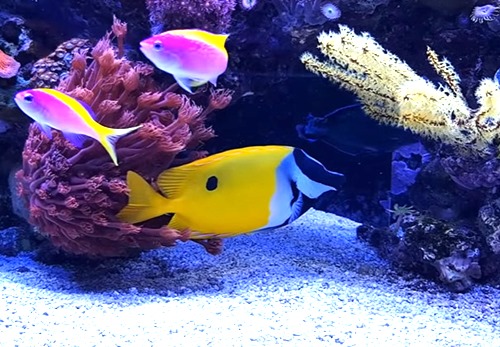
- Min tank size: 70 gallons
- Temperament: peaceful
- Reef safe: yes
- Temperature: 72-78 °F
- Water: pH 8-12, dKH 8.1-8.4, sg. 1.020-1.025
- Max size: 7 inches
- Diet: herbivore
- Care level: moderate
Also called Blotched Foxface. Distinguished from the very similar Foxface Lo by a single spot, usually found on both sides, that can vary in shape, and size from a perfect ‘eyespot’ circle to a blotch.
Wrasses – Fairy
They are a good community tank fish. Wrasses are known for their beautiful coloration, striking patterns, and outgoing personality. Males can change colors, displaying brilliant colored dots, lines, and body areas especially when courting.
They will need open space for free swimming (a tank at least 4 feet long) and many crevices and caves for hiding. They are accomplished jumpers and will so at the slightest provocation, so a tight-fitting canopy is needed. They secret mucus cocoons which they sleep in.
Feed a diet with vitamin-enriched frozen Mysis and brine shrimp, other meaty foods, and high-quality marine flake and pellet foods. They can be a bit pricey and the Chalk Bass may be a suitable alternative.
Suitable reef-safe starter species are the Orange Back Fairy Wrasse (Cirrhilabrus aurantidorsalis) and the Red Velvet Fairy Wrasse (Cirrhilabrus rubrisquamis).
Orange Back Fairy Wrasse (Cirrhilabrus aurantidorsalis)
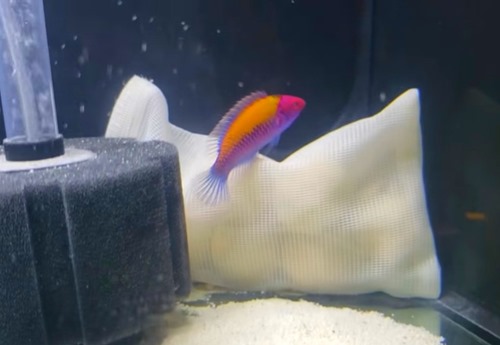
- Min tank size: 75 gallons
- Temperament: peaceful
- Reef safe: yes
- Temperature: 72-78 °F
- Water: pH 8-12, dKH 8.1-8.4, sg. 1.020-1.025
- Max size: 3 1/2 inches
- Diet: carnivore
- Care level: Easy
Also called Orange Back Wrasse. Found in small groups on the reef of the eastern Tomini Bay, Indonesia. Recognized by the yellow-to-orange back in all but very small juveniles. Males have a crimson head, orange back and upper part of the flanks, bright blue belly, and pinkish-red streak along the flanks. They are closely related to C. solorensis.
Red Velvet Fairy Wrasse (Cirrhilabrus rubrisquamis)
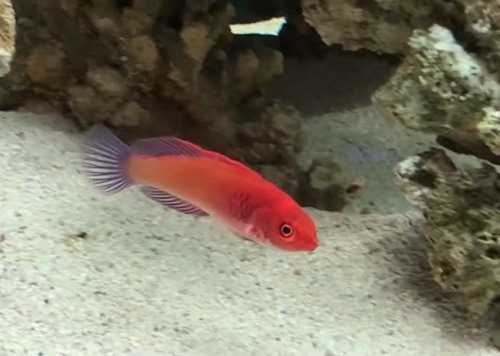
- Min tank size: 70 gallons
- Temperament: peaceful
- Reef safe: yes
- Temperature: 72-78 °F
- Water: pH 8-12, dKH 8.1-8.4, sg. 1.020-1.025
- Max size: 4 inches
- Diet: carnivore
- Care level: Easy
Also known as Rosy-scales Fairy Wrasse. Native to the Western Indian Ocean around the Maldives and Chagos Archipelago. The body front is red in coloration with the remainder being yellow. As it matures, scales toward the front develop dark edges. A courting male will turn almost white on the sides.
Red head solon fairy wrasse (Cirrhilabrus solorensis)
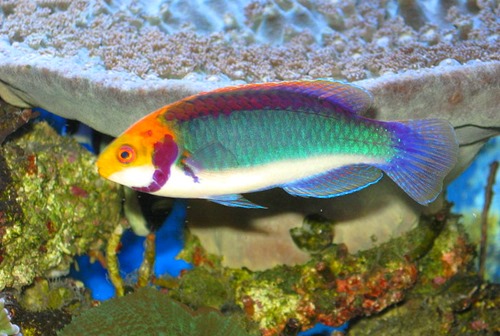
- Min tank size: 75 gallons
- Temperament: peaceful
- Reef safe: yes
- Temperature: 72-78 °F
- Water: pH 8-12, dKH 8.1-8.4, sg. 1.020-1.025
- Max size: 5 inches
- Diet: carnivore
- Care level: Easy
Know also as Tricolor Fairy Wrasse, Redheaded Fairy Wrasse, Redheaded Fairy Wrass, Solor Fairy Wrasse, or Red-Eyed Fairy Wrasse. It is native to Indonesia and Christmas Islands. It has a blue-to-purple body (depending on mood) with bright red running along the dorsal edge and a bright yellow-orange face. Make sure it has a shaded area away from bright lights.
Wrasses – Flasher
Flasher Wrasses are very closely related to fairy wrasses. Their name comes from a males mating behavior where his colors intensify and fins erect while making quick, exaggerated lateral moves. They were relatively unknown to the hobby until 2002.
The tank should have plenty of rockwork with caves and some shaded areas for hiding. They are jumpers so a covered tank is needed.
Feed a diet with vitamin-enriched wet or freeze-dried brine shrimp, high-quality marine flake foods, and a variety of meaty foods. They don’t need a sand bed; they create a mucus cocoon over their bodies for sleep. They can be kept with other Paracheilinus of any species as well as Cirrhilabrus species.
Carpenter’s flasher wrasse (Paracheilinus carpenteri)
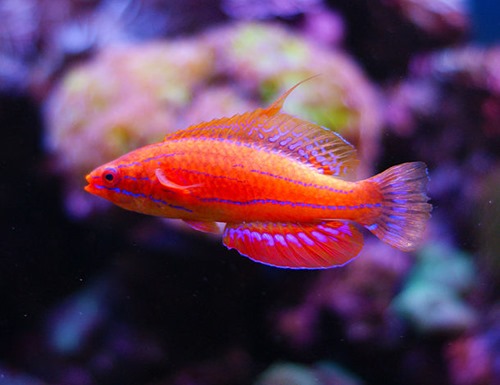
- Min tank size: 55 gallons
- Temperament: peaceful
- Reef safe: yes
- Temperature: 72-78 °F
- Water: pH 8-12, dKH 8.1-8.4, sg. 1.020-1.025
- Max size: 3 inches
- Diet: carnivore
- Care level: Easy
Also called Carpenter’s Wrasse, Redfin Flasher Wrasse and is found in the western Pacific from southern Japan to the Philippines and Palau. Often similar and often confused with P. flavianalis and P. mccoskeri. Carpenter’s wrasses are red on the outer part of the anal fin and have 2-4 filaments.
A grouping is often recommended; having females will encourage the male to color and perform. Introduce females to the tank first and because they can be harassed by other fish, the species is best with peaceful tank mates and introduced first.
References, resources, and more readings
Fish Compatibility Chart: http://www.liveaquaria.com/general/compatibility_chart.cfm
Marine Aquarium fish: http://www.aquaticcommunity.com/sw/
Fairy Wrasses: Newcomers to the Hobby: Tanaka, MD, Hiroyuki at http://www.reefkeeping.com/issues/2006-06/ft/index.php
Flasher Wrasses: Hiroyuki Tanaka, at http://www.reefkeeping.com/issues/2006-08/ht/index.php
Fish Profile: Orchid Dottyback at http://www.reefkeeping.com/issues/2007-12/fish/
You Silly Rabbit: The Genus Siganus: Henry C Shultz, III at http://www.reefkeeping.com/issues/2003-05/hcs3/

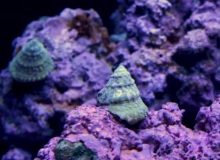
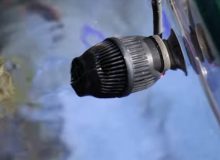
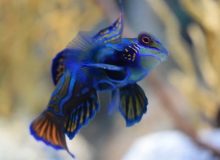
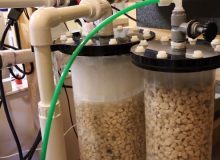
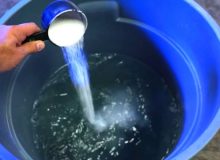
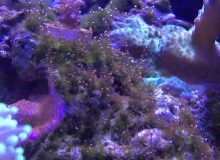
Leave a Reply